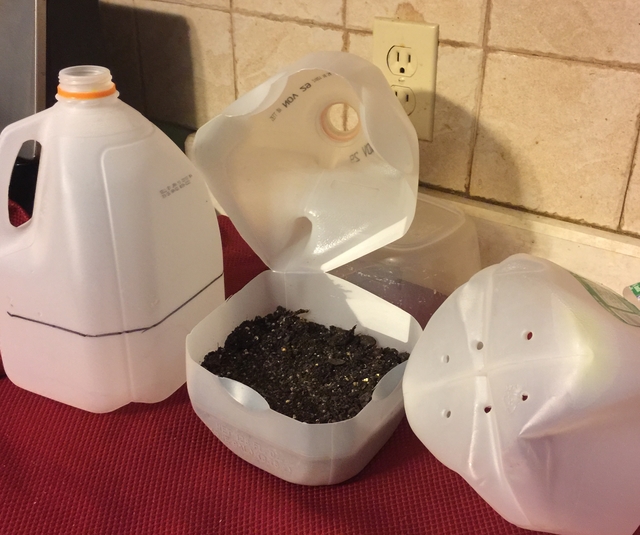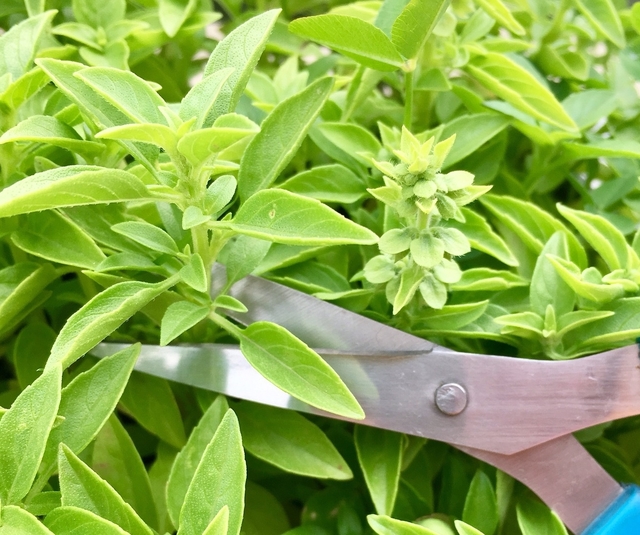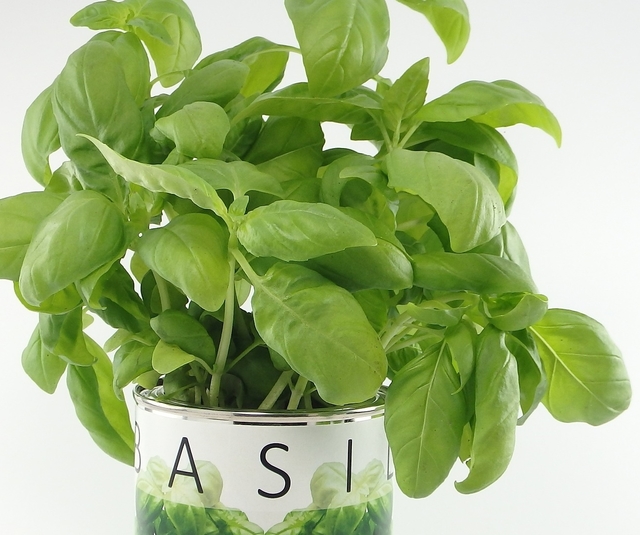Popular types of Basil
Christmas Basil Height: 16-20"
This basil will add a fruity flavor to salads and drinks. It has glossy green leaves and purple flowers.Cinnamon Basil Height 25-30"
This basil has a delightful fragrance and spicy flavor. It has dark purple stems and flowers and small glossy leaves. It's used in fresh arrangements and in fruit salads and as garnishes.
Dark Opal Basil Height 14-20"
Spicy basil in salads, in pesto and as garnishes. Purple stems, flowers, and leaves.Holy Basil Height 12-14"
The leaves are used to make tea for boosting your immune system. Mottled green and purple leaves.Lemon Basil Height 20-24"
Lemon basil is used in fish dishes and iced tea. Light green leaves with white flowers.Lime Basil Height 12-16"
Lime basil is a compact basil with green leaves and white flowers. It's used with fresh fish and chicken dishes, teas and margaritas.Purple Ruffle Basil Height 16-20"
This basil has the same flavor as Opal basil and is used for floral arrangements and garnishes.Sweet Basil Height 14-30"
Sweet Basil is used in Italian sauces and soups and for making pesto. It's more prolific in hot sunny locations.Sweet Tai Basil Height 12-16"
An Asian variety with a distinct spicy anise-clove flavor. Purple stems and blooms with green leaves.Starting Basil from Seed
Seed Longevity: 5 years.
Seed Sowing Depth: Just cover.
Days to harvest: 60-90 days.
Best Soil Temp for Germination: 75-85 degrees.
Days to Germination: 5-10 days.
Spring Sowing
Sow indoors 4-6 weeks before your last frost date. Plant out after all danger of frost has passed.Direct Sowing
Direct sow seeds straight into the garden after the danger of frost has passed.
Winter Sowing
If you haven't tried winter sowing, you're in for a treat. This method is especially good for sowing herbs. Winter sowing is basically sowing seeds in the bottom of milk jugs in the winter, setting the milk jugs outside for the winter and leaving them there until the seeds germinate in the Spring.For our article containing detailed information about Winter Sowing, click here.
Growing Basil
Plant size: See list above.
Growing Soil Temperature: 75-85 degrees.
Spacing: 4-8" apart.
Container Size: 16"-18" diameter.
Soil: Well-drained, moderately rich and loose.
Watering: Light and even.
Light/Sun: Full sun 6-8 hours.
Good Companions: Pepper, tomatoes.
Bad Companions: Beans, cabbage, cucumbers.
Fertilizer:
If grown in rich soil, none. Otherwise, light fertilizer one time during the growing season.

Basil Cuttings
Take a 4" long cutting from a stem that hasn't flowered yet. Remove the leaves from the bottom 2" and place in water on a windowsill. After the roots are 2" long, usually 2-4 weeks, pot in soil and continue to grow.Harvesting Basil
Use fresh basil leaves any time. Basil is at its peak flavor then the buds are about to blossom.Harvest the whole plant before frost, preferably in the morning.
Try Audible and Get Two Free Audiobooks
Harvesting Basil Seeds
Wait until the stem or seed pods turn brown. When the seeds are viable, they will be black in color.
Storing Basil
Fresh
Bouquet Storage
Clean and thoroughly dry the Basil. Trim the end of the stems and remove any wilted or browned leaves. Place the Basil into a Mason jar or clear glass with 1" of water like a bouquet of flowers. Leave at room temperature.Freezing
For best results, use frozen Basil within one year.By freezing herbs, you will lose some of the herb's texture but preserve the flavor.
Here are some suggestions for freezing:
Whole Leaf Freeze
Remove the stems. Blanch the leaves for 2 seconds, then dunk in ice water bath. Dry completely and store in freezer bags.Ice Cube Trays
Remove the stems, clean and thoroughly dry the Basil. Puree one cup of basil with one tablespoon of olive oil. Freeze the pureed basil in ice cube trays firmly packed 3/4 full. Transfer frozen cubes into a labeled freezer bag to store.Flat Freezer Bag
Remove stems, clean and thoroughly dry the Basil. Chop herb into 1/2" pieces, place in a labeled freezer bag. Squeeze out the air, lay flat and freeze.Drying
Basil does not dry well.Using Basil
Basil's rich, spicy flavor, likened to pepper with a hint of mint and cloves, works wonders in pesto, tomato sauces, salads, cheese dishes, eggs, stews, vinegars and all sorts of vegetables. You'll find basil used often in Italian and Thai foods.~~~~~~~~~~~~~~~~~~~~~~~~~~~~~~~~~~~~~~~~~~~~~~~~~~~~~~~~~~~~~~
Growing your own herbs is fun, easy, more healthy than the herbs shipped to grocery stores, and what's best, saves you tons of money! Try it today.
~~~~~~~~~~~~~~~~~~~~~~~~~~~~~~~~~~~~~~~~~~~~~~~~~~~~~~~~~~~~~~~~~~~~~









Comments
Post a Comment